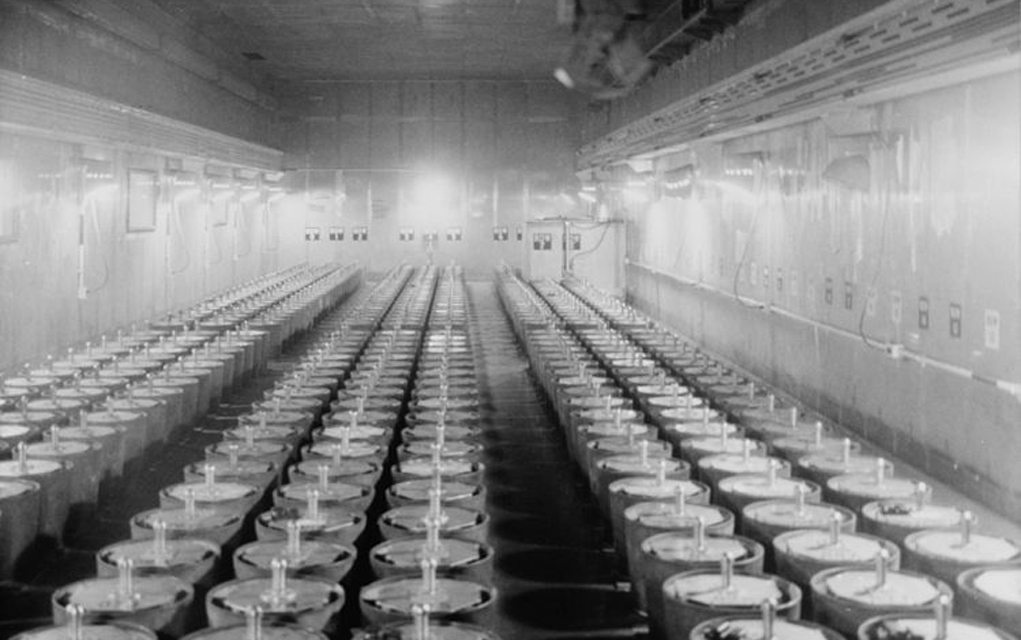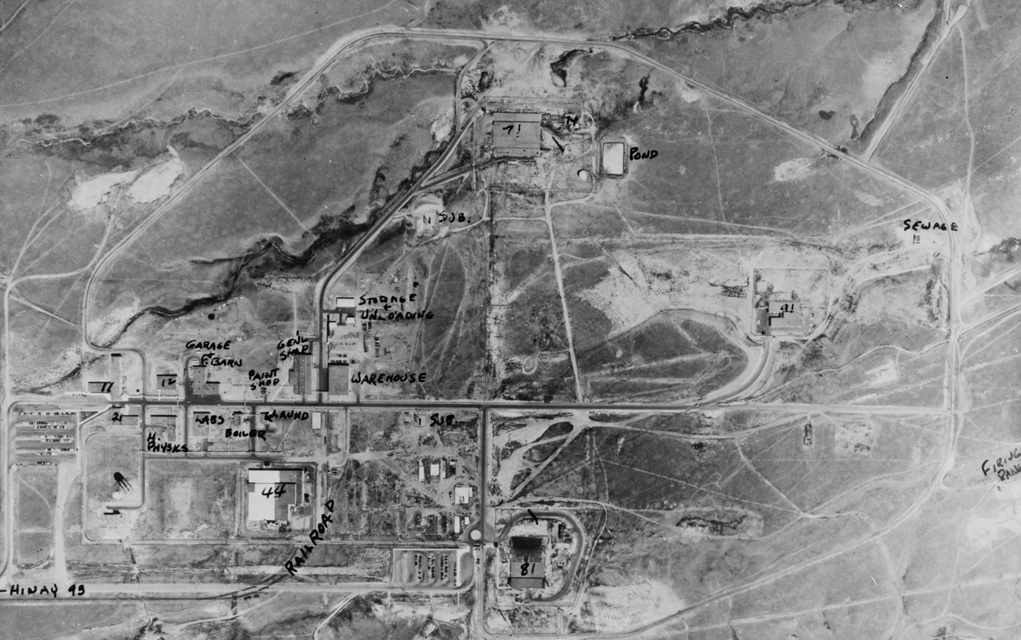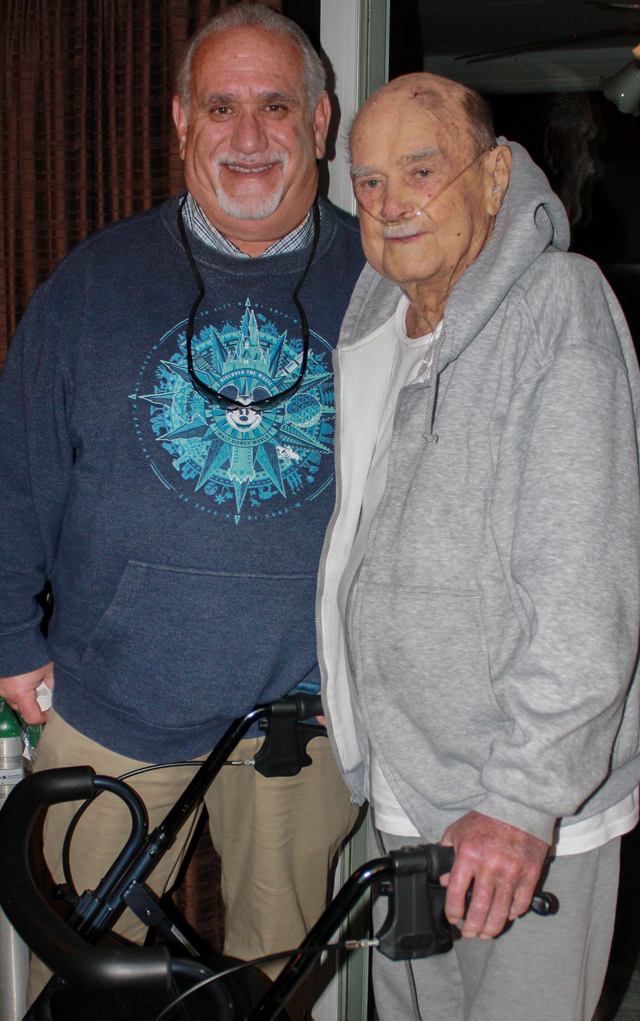
Tony DiGiallonardo doesn’t regret anything about his job at the Rocky Flats Plant, producing nuclear weapons parts for the federal government. His work in the R&D department was interesting — varied, not monotonous.
Plus, after working construction jobs, his last helping to build Rocky Mountain Arsenal, the pay at Rocky Flats was much better: $1.30 an hour when he first started in 1952.
“That was great money,” he says with a laugh, from his home in Longmont, which he built himself 60 years ago.
In the beginning, DiGiallonardo says, he would carry unprotected half and full shells of plutonium through the drafty tunnels between buildings, keeping the components near his abdomen for warmth.
“I always carried it on my right side and now you can’t even go 10 feet close to it without lead aprons and lead gloves and everything else,” he says. “You walked through the cold tunnel and that warm ball just kept you warm right there.”
It wasn’t until after he retired in August 1989 that he got sick. During his nearly four decades of work he was exposed to a variety of radiation and toxic substances, not only plutonium but uranium, beryllium and asbestos as well. It started in his lungs, and he’s since been diagnosed with berylliosis, or chronic beryllium disease (CBD), asbestosis, emphysema and chronic obstructive pulmonary disease (COPD), all diseases that slowly replace lung tissue with scar tissue and can be terminal. He had his first bout of cancer in the 1990s: colon cancer, requiring five rounds of chemotherapy and surgery to remove 17 inches of intestines. Later, he fought bladder and thyroid cancer.
“Right at the beginning everyone thought it was safe,” DiGiallonardo says. “We handled [the plutonium] real good, I thought, but they said, no we didn’t.”

The son of Italian immigrants, DiGiallonardo was born in Berwin, Colorado, at a coal mining camp near Walsenburg. Two of DiGiallonardo’s five brothers also worked at Rocky Flats, Louie in production and Sam, who eventually transferred to the nuclear weapons lab in Livermore, California. Louie died of pancreatic cancer, and Sam passed away from lung cancer. Both his son and nephew also worked at the plant until it closed in 2005.
Today, at age 91, his lungs are what give DiGiallonardo the most trouble. Pneumonia recently landed him in the ICU for a few weeks in September. After years of independence — golfing five days a week, mowing his yard, taking care of his house, even driving himself to the hospital — DiGiallonardo now relies on the help of in-home health care around the clock, paid for by the federal government.
“I don’t think I’ll ever get rid of this oxygen,” he says, pointing to the tank sitting by his recliner chair. Several canisters are stocked out on the porch behind him.
The Energy Employees Occupational Illness Compensation Program Act (EEOICPA) was passed in 2000, providing monetary compensation and medical coverage for former Department of Energy workers who were exposed to radiation or toxic substances at certain facilities and as a result were later diagnosed with specific radiogenic cancers and/or respiratory illnesses.
But recent changes in regulations have made accessing in-home health care even more complicated, according to several Colorado care providers that specifically cater to former energy workers, especially those from Rocky Flats. They say the changes can result in a delay of care for their clients, which goes against the spirit of the law. EEOICPA was enacted in order to make the process straightforward, recognizing that for years the former energy workers who helped the U.S. build its nuclear defense had been fighting the government to get just compensation and coverage for their work-related illnesses.
• • • •
According to the Department of Labor (DOL), which administers the program, to date EEOICPA has provided $17.3 billion in both compensation payouts and medical benefits to 126,000 people who worked at a variety of facilities throughout the country.
Former Rocky Flats employees are eligible if they worked at the plant before 1984, people like DiGiallonardo. (People who worked at the plant after that time and may have been exposed to toxic substances as part of their work are also eligible for benefits, although they have to go through a different process requiring a complicated dose reconstruction based on records. Some former Rocky Flats employees are currently petitioning to change that.)

Monetary compensation under the EEOICPA includes a $150,000 lump sum energy workers receive as soon as their claim is accepted, with the possibility of getting up to $250,000 over their lifetime based on the degree of impairment or disability they experience due to their work-related illness. Additionally, there is room for coverage of consequential health issues that are a direct result of the primary illness — anything from sleep apnea to atrial fibrillation, maybe even dementia, says Elizabeth Brooks, a registered nurse by background who became an advocate for former energy workers about 10 years ago. Today Brooks helps clients through the claims process to get coverage through the EEOICPA.
The medical benefits include all expenses — no copays, no out-of-pocket minimums — related to their specific illness, as well as complete coverage of around-the-clock in-home health care and medical equipment — everything from a walker to daily oxygen — for the remainder of their lives.
“It’s very unique,” Brooks says. “It’s a great program really for what it does and the home health they can get goes way beyond anything else they can get from Medicare… They can actually have someone with them 24 hours a day if they need it.”
Even though the act was passed in 2000, Brooks says accessing the in-home health care benefits has really expanded in the last several years, in large part because of the outreach in-home health care companies like Colorado’s Professional Case Management (PCM), Nuclear Care Partners (NCP) and others have done to make people aware of the benefits. Plus, she says, “with today’s technology people are living longer, going into remission.”
However, with an almost 800-page manual, “The program is very complicated,” Brooks says, making a job like hers necessary.
“The people who are trying to access the benefits are often elderly, they’re ill and they’ve been at it for a number of years just trying to work their way through their program,” says Greg Austin, president of Denver’s PCM, which has been working with former Rocky Flats workers for the past 17 years, one of the first to provide in-home health care under EEIOCPA. “So it can be very frustrating.”
This year, Austin says, it got even more complicated as the DOL implemented some rule changes in April, which he says extend the authorization process for in-home health care.
Before the rule changes, authorization through EEIOCPA took about a week, if all went smoothly, Austin says. On average, however, it would 50 days for approval from the time of first assessing a patient and their needs to the time in-home health care was approved, he says. But care-providers like PCM and NCP would often start providing care while the paperwork was processing, knowing that when approved, the benefits could be applied retroactively, as long as there was a clear medical justification for the care. Now, under the rule changes, the process is taking even longer, a minimum of 60 days, Austin says, and pre-authorization is required, meaning that care-providers can’t start working with clients until the in-home care is approved by the DOL.
“There are a number of situations where people’s health care needs can’t wait for this process to play out,” Austin says. “People’s needs vary. There are some patients whose needs are on the lower end, more of a nurse visit, and a delay is not going to have the same impact as somebody who’s getting discharged from a hospital, somebody whose illness takes a significant turn for the worse.”
The DOL maintains that the official rule changes are largely a formality, reflecting how the current process plays out and implementing procedures that have really been in effect since 2006, according to an email statement from a spokesperson. Before the changes, approximately 50% of claims were processed within 60 days, according to DOL. Now, more than 95% of the claims have been processed in the same time period. Additionally, the only real change is that claimant’s now have to provide the name of their doctor so the department can contact them directly with any questions about the request for home health care, the DOL says.
Still, NCP and PCM say the change in process has become much more cumbersome and, in their experience, is taking longer than it used to.

“We recognize that the Department of Labor’s intention with these changes was to increase the efficiency of processing times for authorization, however, with any change, unintentional consequences may occur,” says Lori Shanks, NCP community outreach manager for Colorado. “From a health care perspective, it is of the utmost importance that our beneficiaries are able to access their benefits in a way that is timely, effective and consistent with their level of need. We have witnessed patients, at times, experience lengthy wait times and added steps for authorization due to this new process change.”
What used to be an eight-step process, Shanks says, is now a 32-step process requiring multiple mail-in forms and doctor’s signatures, which, she says, is adding weeks to an already lengthy process.
There is, however, an emergency approval process, that only takes a day or two, for people who need immediate in-home health care. DiGiallonardo, for example, was able to get signed up for home health care benefits while still in the hospital with pneumonia. But Shanks has only processed a handful of cases like his, she says. It’s much more common for the approval process to stretch on for months. NCP claims there’s been at least one case of a client dying before their in-home health care was approved.
And, according to Austin, the emergency relief doesn’t consistently work. “It’s not very clear as to what constitutes an emergency and what doesn’t, so it’s a difficult tool to use,” he says.
On top of that, Austin says, the additional forms make it more difficult for in-home health nurses, like those who work for PCM and NCP, to assist in the process, leaving the former workers to try and navigate the federal benefits program on their own. Plus, new procedures for targeted case management limit the amount of time — only 15 minutes per week — nurses can coordinate care plans as part of their case management responsibilities, he says.
“This is a very small population of former workers. So it’s not ubiquitous like Medicare would be,” Austin says. “Even the doctor is not that familiar with the program and they’re not sure what to do to get the care approved. And that’s where companies like ours and NCP are able to fill those gaps.”

In response, NCP advises EEOICPA medical card holders to start the process early, as a preventative measure. Even if they only get a visit once a month, at first, it could mean they avoid missing out on care when it’s really needed, Shanks says.
PCM, on the other hand, filed a legal challenge against the new regulations, arguing the new process is in violation of the statute establishing the program.
“Congress was very clear when they created this law that they wanted this to be a more seamless, straightforward process for people whose illnesses were caused by their workplace exposure to gain access to medical benefits,” Austin says. “Anything that unnecessarily makes it more difficult to access the benefits we think is not in alignment with the spirit of the law.”
The DOL declined to comment on the pending litigation.
Regardless of the challenges the in-home health care providers and claimants are experiencing due to the recent changes, the coverage of care for those who are approved is a life-saver.
For DiGiallonardo, and his family, it really has made all the difference.
The eight NCP nurses working with him have become a part of the family, his son Mike says, communicating regularly with obvious care and concern for DiGiallonardo.
“We’re emotionally attached and not very good caregivers,” Mike says of himself and his sister, both of whom live in the area. “There’s no way my sister and myself could ever do this. There’s just no way.”

It’s allowed DiGiallonardo to stay comfortable, living in his own home, sleeping in his own bed.
“It’s like living in heaven,” he says. “I love it here, even if I have to struggle once in awhile.”
Ensuring that other former Rocky Flats and energy workers are afforded the same level of care when they need it is what’s driving PCM’s lawsuit, and the concerns expressed by other care providers.
“We just want to make sure that the beneficiaries have access to these much needed medical benefits,” Austin says. “You can imagine when someone needs in-home care, it’s usually much needed, and needed in a timely manner. Care that is delayed is really care that is denied, right? Because you can’t make it up later on.”
Editor’s note: As of Dec. 19, Boulder Weekly learned that Tony DiGiallonardo passed away.














